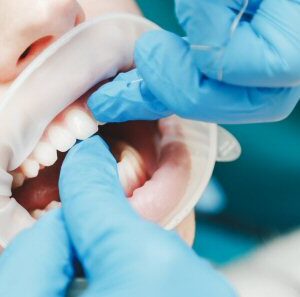Crowns & Bridges
 Dental crowns are a perfect example of dentistry being both an art and a science. A tooth that is broken, rotten, or unsightly might be covered with a dental crown, often known as a “cap.” As part of dental bridgework, it can potentially totally replace a tooth.
Dental crowns are a perfect example of dentistry being both an art and a science. A tooth that is broken, rotten, or unsightly might be covered with a dental crown, often known as a “cap.” As part of dental bridgework, it can potentially totally replace a tooth.
Above the gum line, a crown entirely encases a tooth. This contrasts with a dental veneer, which merely covers the front of a tooth and requires healthy tooth structure to support it. A crown would therefore be the preferred restoration if a tooth has a large amount of structure above the gum line missing.
Strengthening teeth with crowns enables them to resume normal function after damage. Crowns are essentially indistinguishable from natural teeth when made from the high-tech porcelains (dental ceramics) of today. Even better, they can be created to enhance a tooth’s natural beauty. Depending on the characteristics that are most crucial, we can also create dental crowns out of materials other than porcelain. Cast gold is unsurpassed in terms of sturdiness. However, particularly in the front of the mouth, this is not usually the most aesthetically pleasing option. We are more than pleased to go over all of your options with you.
Crowning or Capping a Tooth
It typically requires two to three appointments to cap or crown a tooth. We will get your tooth ready for its new crown during the initial appointment. To begin with, we shall shape it to fit the new covering. To give the tooth a consistent shape, some drilling will be required. Earlier on, we shall numb the tooth and the surrounding area. If there isn’t much tooth structure left to begin with, building up the tooth with filling material can be necessary rather than removing it in order to support the crown.
After the tooth has been cleaned and prepped, we will either take digital impressions of your teeth or use durable impression materials that resemble putty before sending them to the dental lab. There, models of your teeth made from the impressions will be utilised to create a crown. The highly qualified lab experts will use the models as a guide to make sure that your new crown is made to improve your smile and work properly within your bite.
We will place a temporary crown on your tooth before you leave the office to keep it safe until the permanent crown is prepared. Your permanent crown will be affixed to your tooth at the second appointment using either a resin that hardens when exposed to a certain light source or an unique kind of permanent cement.
Creating a Bridge
Crowns can also be used to fashion a convincing tooth substitute for a missing one. This is accomplished using bridgework, which spans the gap left by the missing tooth and calls for a minimum of three crowns. On either side of the gap left by the lost tooth, two of those crowns will be affixed to healthy teeth known as abutment teeth. A pontic, or third crown, is positioned in between the two crowned abutment teeth and is supported by those two teeth. To fill the space left by missing teeth, more crowns will be required if there are multiple missing teeth.
Caring for Crowns & Bridges
The same meticulous maintenance is necessary for crowns and bridgework as it is for natural teeth. You prevent dental plaque from accumulating, make sure to brush and floss daily between all of your teeth, both natural and repaired. Maintaining your regular schedule of dental cleanings here at the clinic is especially crucial if you have crowns. Try not to use your teeth as tools (to open packages, for example). It would be a good idea to wear a nightguard if you grind your teeth frequently to protect your teeth and your investment.
